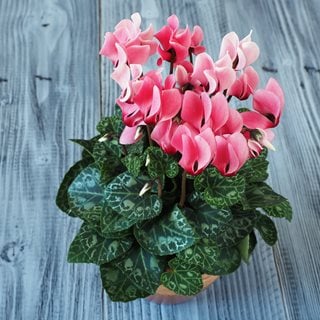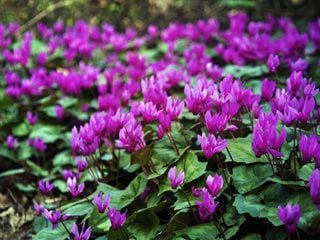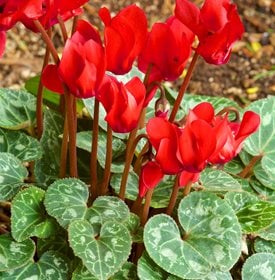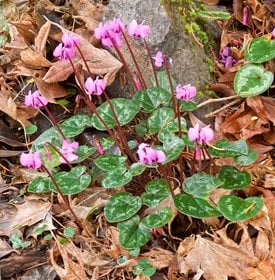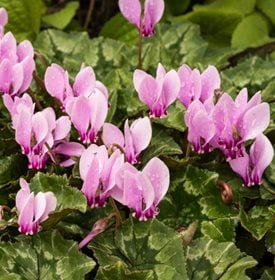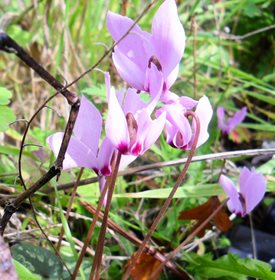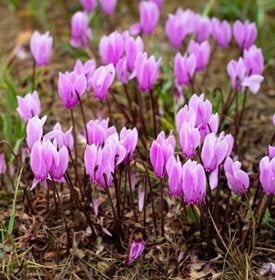How to Grow & Care for Cyclamen Plants
Grow these charming flowering plants indoors or outsideVibrant ballerina-like flowers and intriguing foliage make cyclamen a popular choice among avid gardeners and homeowners. This tuberous perennial can be grown indoors as a houseplant or outdoors in rockeries and woodland gardens. Plants begin actively growing in fall, going dormant during warm summer months.
On this page: Basics | Planting | Care and Maintenance | Pictures | Design Ideas
On this page:
- BASICS
- PLANTING CYCLAMEN
- CYCLAMEN CARE AND MAINTENANCE
- CYCLAMEN VARIETIES
- CHOOSE THE RIGHT CYCLAMEN
- DESIGN IDEAS
BASICS
Botanical name:
Cyclamen spp.
Plant type:
Cyclamen is a cool weather perennial grown from a flat disc-like bulb, which is also referred to as a tuber.
Zones:
Persian cyclamen is hardy in zones 9-11, while hardy species can grow in zones 4-9.
Height/Spread:
Upright mounding or spreading habit, 2 to 16 inches tall and 4 to 16 inches wide
Exposure:
Bright indirect light indoors; partial to full shade outdoors
Bloom Time:
Late summer to early spring, depending on the species
Flowers:
Lightly scented cyclamen flowers have five upswept curved petals in colors of white, pink, purple, salmon, red or bicolors. Blooms are borne singularly on slender flower stems that rise above compact clumps of foliage.
Foliage:
Heart-shaped, ivy-shaped, triangular, or rounded leaves come in shades of green, silver, or white in solid colors or patterns. Leaf undersides can be green or purple.
Toxicity:
Cyclamen contains toxic saponins, which are present in the entire plant but more concentrated in the bulbs, and can cause mild to severe symptoms.
Are cyclamen deer resistant?
Cyclamen is considered deer-resistant, though may be susceptible to deer browsing if other food sources are scarce.
PLANTING CYCLAMEN
When to plant:
Indoor plants can be purchased in fall or winter. Plant tubers outdoors in late summer or early fall.
Where to plant:
Place indoor potted plants in a window that receives bright indirect light. Plant outdoor bulbs in a site with well-draining soil that receives part to full shade.
How to plant:
Hardy cyclamen looks best when bulbs are grouped together. Loosen soil in planting area and amend with compost or decomposed leaf clippings. Place bulbs so the top is just below the soil surface and space 6 inches apart.
Planting cyclamen in pots:
Make sure pots have adequate drainage holes. Use a high quality all-purpose potting soil. Bulbs can be planted individually in smaller pots or grouped together in a larger container.
For more on how to plant bulbs or tubers:
Bulbs 101: Planting and Storing Bulbs
CYCLAMEN CARE
Temperature & humidity:
Cyclamen prefers cooler temperatures between 50-70 degrees F. Keep houseplants out of extreme heat or drafts. If temperatures are too high, flower buds will fail to develop and plants will go dormant prematurely. Place pots on trays filled with water and pebbles to increase air humidity.
Water:
Cyclamen prefer moderate water and are somewhat drought-tolerant when naturalized in the garden. Allow to dry out between waterings. Overwatering can cause bulb rot. Cease watering when plants go dormant. For houseplants, avoid splashing the leaves or crown to prevent rot.
Soil:
Provide amended, well-draining soil with a slightly acidic pH between 6.0 and 7.0. Plants can tolerate a variety of soil conditions as long as there is good drainage. Amend heavier soils with organic material to improve drainage. Houseplants can be grown in a high quality all-purpose potting mix.
Pruning:
Deadhead spent flowers to encourage rebloom, and remove dead or damaged foliage as needed.
Dormancy care:
Clean up any leaf debris once plants go dormant. For indoor houseplants, store dormant bulbs in a cool, dark place. Lightly water or mist if needed to prevent bulbs from becoming too dry. Resume watering in late summer or early fall and begin fertilizing when new growth appears. Move plants into bright indirect light. Outdoor hardy varieties need no special care.
Repotting:
Potted cyclamen can be treated as annuals or regrown the following season. Repot every two years during summer when plants are dormant. Use fresh potting soil and a slightly larger pot than the previous one. Place the bulb so the top is sticking slightly out of the soil.
Fertilizer:
Hardy cyclamen planted in well-amended soil need little to no supplemental fertilizer. For indoor houseplants, fertilize every 3 to 4 weeks. Apply a water soluble fertilizer with a lower nitrogen number at half strength. Too much nitrogen will promote lush foliage at the expense of flowers. Cease fertilizing when plants begin dormancy.
Diseases and Pests:
When planted in the right conditions, they have few insect or disease problems. Pests include cyclamen mites, aphids, leaf roller, nematodes, and thrips. Diseases include bacterial soft rot, botrytis, fusarium wilt, root rot, and leaf spot.
CYCLAMEN VARIETIES
Native to the Mediterranean region, there are over 20 Cyclamen species. Persian cyclamen (Cyclamen persicum), also known as florist’s cyclamen, is a common houseplant found in garden centers and grocery stores at Christmas and Valentine’s Day. Hardy forms, such as Cyclamen coum and Cyclamen hederifolium, brighten up the garden from fall into early spring when little else is in bloom.
Cyclamen alternatives:
Good substitutes for cyclamen include spring- or fall-blooming crocus, species tulips, and snowdrops.
HOW TO CHOOSE THE RIGHT CYCLAMEN
For borders and landscapes: Hardy cyclamen naturalizes well in rockeries, alpine gardens and woodland settings.
For slopes and hillsides: Use as an understory plant for woodland shrubs or trees that grow along a slope.
For containers: Houseplant forms are suitable for any type of smaller pot. Most hardy types do well in containers as long as pots are protected from extreme cold.
DESIGNING WITH CYCLAMEN
There are many ways to incorporate cyclamen into your home and landscape. Here’s how:
- Use Persian cyclamen as a centerpiece in a holiday tabletop display or give as a holiday gift.
- Place a Persian cyclamen in an office window that gets bright indirect light to help stave off the winter blues.
- Group Persian cyclamen with poinsettias in different hues for a dazzling holiday display.
- Mass winter-blooming hardy types underneath trees with winter interest such as stewartia, paperbark maple, or witch hazel for a stunning seasonal display.
- Naturalize hardy cyclamen with different bloom times for a succession of color from early fall through spring.
- Plant hardy cyclamen in combination with alpine and rock garden plants that bloom in spring or summer for continuous color nearly year-round.
Companion plants for cyclamen:
Many woodland or alpine plants pair well with cyclamen. Winter- or early-spring-blooming companions include hellebores, winter aconite, trillium, and narcissus. Fall companions include sedums, witch hazel, fall crocus and beautyberry.
RELATED:
Top 20 Spring-Blooming Bulbs
16 Winter Flowers for Your Garden
All-Star Spring Flowers
